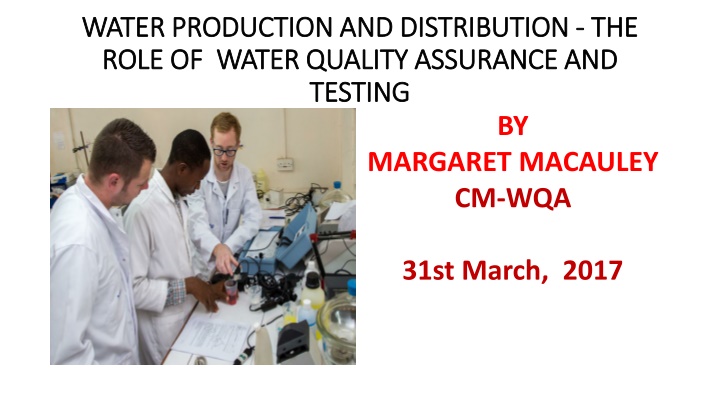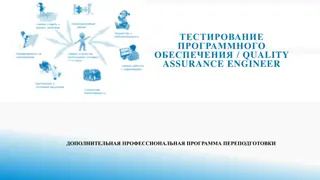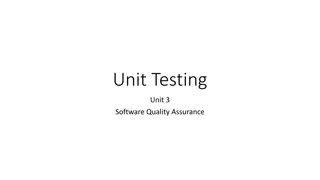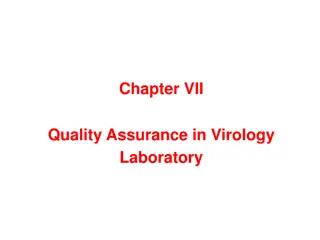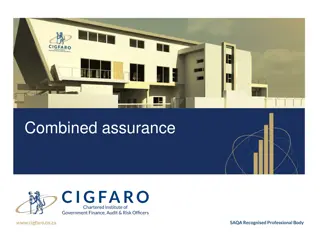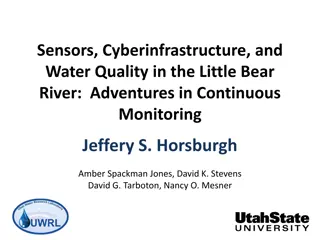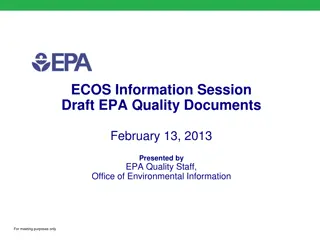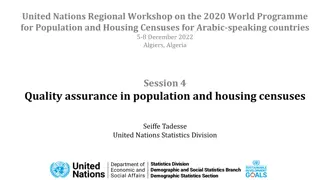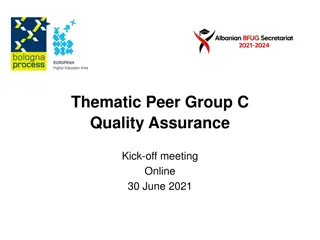Water Quality Assurance and Testing Roles
The role of water quality assurance in water production and distribution is crucial for ensuring safe and clean water supply to consumers. The Ghana Water Company Ltd aims to provide water free from harmful substances and in adherence to quality standards. The Water Quality Assurance Department upholds core values of professionalism, innovation, and safety, emphasizing the non-negotiable nature of quality and safety in water management. Responsibilities include pollution management, raw water quality monitoring, chemical management, treatment plant operation, and distribution system surveillance to maintain water quality.
Download Presentation

Please find below an Image/Link to download the presentation.
The content on the website is provided AS IS for your information and personal use only. It may not be sold, licensed, or shared on other websites without obtaining consent from the author.If you encounter any issues during the download, it is possible that the publisher has removed the file from their server.
You are allowed to download the files provided on this website for personal or commercial use, subject to the condition that they are used lawfully. All files are the property of their respective owners.
The content on the website is provided AS IS for your information and personal use only. It may not be sold, licensed, or shared on other websites without obtaining consent from the author.
E N D
Presentation Transcript
WATER PRODUCTION AND DISTRIBUTION WATER PRODUCTION AND DISTRIBUTION - - THE ROLE OF WATER QUALITY ASSURANCE AND ROLE OF WATER QUALITY ASSURANCE AND TESTING TESTING THE BY MARGARET MACAULEY CM-WQA 31st March, 2017
GOALS OF GHANA WATER COMPANY LTD GOALS OF GHANA WATER COMPANY LTD To produce and supply the Ghanaian consumer with water that is free from visible suspended matter, colour, turbidity, taste, odour and also free from disease causing organisms. It should not contain any substances that are injurious to health and should not be corrosive. To ensure that treated water from the treatment plants conform to the Ghana Drinking Water Quality Standards. This means that the water must be clean, safe, wholesome and non-corrosive and should remain in this condition throughout the distribution system to its final destination the consumer s tap. .
WATER QUALITY ASSURANCE WATER QUALITY ASSURANCE ( (WQA) DEPARTMENT WQA) DEPARTMENT CORE VALUES Professionalism, Innovation, Safety Commitment MOTTO : Quantity and price are negotiable but quality and safety are not
ROLES AND RESPONSIBILITIES OF WQA ROLES AND RESPONSIBILITIES OF WQA DEPARTMENT DEPARTMENT WATER POLLUTION MANAGEMENT Collaboration with Water Resources Commission and other stakeholders in pollution control and management RAW WATER QUALITY MONITORING Raw water monitoring to determine treatability and health effect levels WATER TREATMENT CHEMICALS MANAGEMENT Programming for re-ordering treatment chemicals to ensure adequate quantities Supervision and monitoring of Chemical usage at headworks to reduce wastage. Monitoring and managing stock at Regional and Central Stores.
ROLES AND RESPONSIBILITIES OF WQA DEPARTMENT WATER TREATMENT AND QUALITY CONTROL Effective operation of unit processes at the treatment plants Judicious and cost effective application of chemicals Elimination of health effects DISTRIBUTION WATER QUALITY SURVEILLANCE AND CONTROL Ensuring the cleaning of treatment plant water retaining structures and service reservoirs Ensuring the flushing and care of distribution system Assuring quality through sampling and analysis of distribution system
ROLES AND RESPONSIBILITIES OF WQA DEPARTMENT ROLES AND RESPONSIBILITIES OF WQA DEPARTMENT RESEARCH AND BENCH SCALE TESTS Testing of all treatment chemicals for efficacy and suitability Running of bench scale and piloting for new treatment Chemicals, eg. Polyelectrolytes MONITORING PLANT DOSING EQUIPMENT Calibration and monitoring efficiency of all dozers (wet and dry) Ensuring the installation and function of those yet to be installed. . REGULATORY AND TARGETS COMPLIANCE Ensuring achievement of targets viz bacteriology, turbidity, pH, Colour and Residual Chlorine.
ROLES AND RESPONSIBILITIES OF WQA ROLES AND RESPONSIBILITIES OF WQA DEPARTMENT DEPARTMENT PLANNING AND DEVELOPMENT Role in the construction of new treatment plants and rehabilitation of old ones LABORATORY EQUIPMENT, ANALYTICAL CHEMICALS AND REAGENTS Indenting for supply of laboratory equipment (replacements) Indenting for analytical chemicals/Laboratory reagents to replenish stocks WATER QUALITY DATA MANAGEMNET Compilation, storage, accessibility, and management of water quality data Ensuring proper data processing and management reporting for all regions and units.
ROLES AND RESPONSIBILITIES OF WQA ROLES AND RESPONSIBILITIES OF WQA DEPARTMENT DEPARTMENT WATER SAFETY PLAN IMPLEMENTATION Identifying priority areas to invest for improvement in operations to ensure water safety STAFFING AND TRAINING Ensuring adequate personnel in regions Programming and planning training for water quality and treatment personnel (Operators and Technicians)
Quality Assurance Quality Assurance - - Treatment Plants and Distribution Treatment Plants and Distribution Systems Systems The production processes are monitored on hourly basis at the treatment plant to ensure that the final water meets the Ghana Drinking Water Standards Samples are also collected and analyzed from the distribution system on daily basis Example: Greater Accra has 22 districts. 30 water samples taken per district per month. Total of Six Hundred and Sixty (660) water samples per month. Followed by lab. Analysis and information sharing Compliance is 98-100% for safety parameters 9
Other Quality Assurance interventions Other Quality Assurance interventions Sanitary surveys and education at consumers premises Water sample taking at consumers' premises Boosting of chlorine residual in the distribution systems, Regular cleaning of buffer reservoirs and GWCL's water tankers. Collaboration WQA Department, the Call Center and the Distribution to ensure that consumer complaints are attended to and recommendations from the Quality Assurance Department are addressed. 10
SWOT ANALYSIS: STATUS OF WQA DEPARTMENT SWOT ANALYSIS: STATUS OF WQA DEPARTMENT STRENGTHS WEAKNESSES OPPORTUNITIES THREATS one of the key operational departments in the company poor laboratory set- ups some weak and obsolete laboratory equipment low ICT application in laboratories Readiness of staff to rise up to challenges low awareness of the relevance of water quality and health highly motivated staff availability of trained/professional human resources poor customer attitude frequent pipe-bursts high customer alertness on WQ lack of timely replacement of equipment lack of some consumables in laboratories Lack of adequate training for staff Qualified staffing and junior level availability of nine (9) regional laboratories (evenly distributed) frequent staff exit (crossing to other departments ready support from Management and sister departments Delays in procurement of treatment chemicals and lab reagents availability of plant laboratories
SWOT ANALYSIS SWOT ANALYSIS STRENGTHS WEAKNESSES OPPORTUNITIES THREATS availability of some vehicles for assignments -availability of treatment chemicals -availability of some important laboratory equipment. -availability of some reagents for testing -availability of built capacity in Water Safety Plans (WSPs lack of commitment from some staff Weak distribution system poor laboratory infrastructure on some plants very limited Standard Operating Procedures (SOPs) on plants lack of capacity in filter management over-aged vehicles for sampling jobs unstable power supply extensive capacity in water testing available Non-adherence to advice from WQAD -low morale of some staff in department Water quality is key to the attainment of the SDGs Water quality is beginning to receive attention nationally
GWCL INTERNAL DRINKING WATER QUALITY GWCL INTERNAL DRINKING WATER QUALITY MONITORING TARGETS( KEY INDICATORS) MONITORING TARGETS( KEY INDICATORS) No SAMPLING TARGET REGION PLANT SAMPLING DSTRICT SAMPLING UNIT ATMA ASH PROD. 540 - ASH NORTH - 300 ASH SOUTH - 300 CR WR ER NR BA VR UER UWR 1 2 NO NO 540 1,560 540 510 540 570 360 200 450 540 270 240 270 140 90 90 90 90 PLANT 3 4 5 TURBIDITY COLOUR pH NTU HU 2 5 2 5 2 5 2 5 2 5 2 5 2 5 2 5 2 5 2 5 2 5 2 5 7.0-8.5 *(incl) 0.5-1 *(incl) 100% -ve 7.0-8.5 *(incl) 0.5-1 *(incl) 100% -ve 7.0-8.5 *(incl) 0.5-1 *(incl) 100% -ve 7.0-8.5 *(incl) 0.5-1 (*incl) 100% -ve 7.0-8.5 *(incl) 0.5-1 *(incl) 100% -ve 7.0-8.5 *(incl) 0.5-1 *(incl) 100% -ve 7.0-8.5 *(incl) 0.5-1 *(incl) 100% -ve 7.0-8.5 *(incl) 0.5-1 *(incl) 100% -ve 7.0-8.5 *(incl) 0.5-1 *(incl) 100%- ve 7.0-8.5 *(incl) 0.5-1 *(incl) 100%- ve 7.0-8.5 *(incl) 0.5-1 *(incl) 100%-ve 7.0-8.5 *(incl) 0.5-1 (*incl) 100%-ve 6 RESIDUAL CL2 mg/L 7 BACTERIOLOGICAL CFU/ML DITRIBUTION 8 TURBIDITY *** NTU 95% 2 5 95% >7.0 0.1 (**) 95% -ve UNOFFE NSIVE 95% 2 5 95% >7.0 0.1 (**) 95% -ve UNOFFE NSIVE 95% 2 5 95% 2 5 95% 2 5 95% >7.0 0.1 (**) 95% -ve UNOFFE NSIVE 95% 2 5 95% 2 5 95% >7.0 0.1 (**) 95% -ve UNOFFE NSIVE 95% 2 5 95% >7.0 0.1 (**) 95% -ve UNOFFE NSIVE 95% 2 5 95% >7.0 0.1 (**) 95% -ve UNOFFE NSIVE 95% 2 5 95% >7.0 0.1 (**) 95% -ve UNOFFE NSIVE 95% 2 5 95% 2 5 9 COLOUR pH HU 10 95% >7.0 95% >7.0 95% >7.0 95% >7.0 95% >7.0 11 RESIDUAL CL2 mg/L 0.1 (**) 95% -ve 0.1 (**) 95% -ve 0.1 (**) 95% -ve 0.1 (**) 95% -ve 0.1 (**) 95% -ve UNOFFE NSIVE 12 BACTERIOLOGICAL CFU /ML 13 ODOUR & TASTE UNOFFE NSIVE UNOFFEN SIVE UNOFFEN SIVE UNOFFEN SIVE UNOFFENSI VE *(inclusive ) ** at furthest end ***5% Turbidity >2 should not be >5
Water Quality Parameters Monitored by GWCL Water Quality Parameters Monitored by GWCL PHYSICOCHEMICAL PARAMETERS No Parameter No Parameter No Parameter 1 11 pH Iron 21 Zinc 2 12 Colour Manganese 22 Lead 3 13 Turbidity Fluoride 23 Copper 4 14 Residual Chlorine Nitrate 24 Arsenic 5 15 Conductivity Phosphate 25 Pesticides 6 16 Hardness Nitrite 7 17 Chloride Ammonia 8 18 Total Dissolved Solid Cadmium 9 19 Sulphate Chromium 10 20 Aluminium Mercury
Water Quality Parameters Monitored by GWCL BACTERIOLOGICAL Parameter No 1 2 3 Total Bacteria count Total Coliform E. Coli
